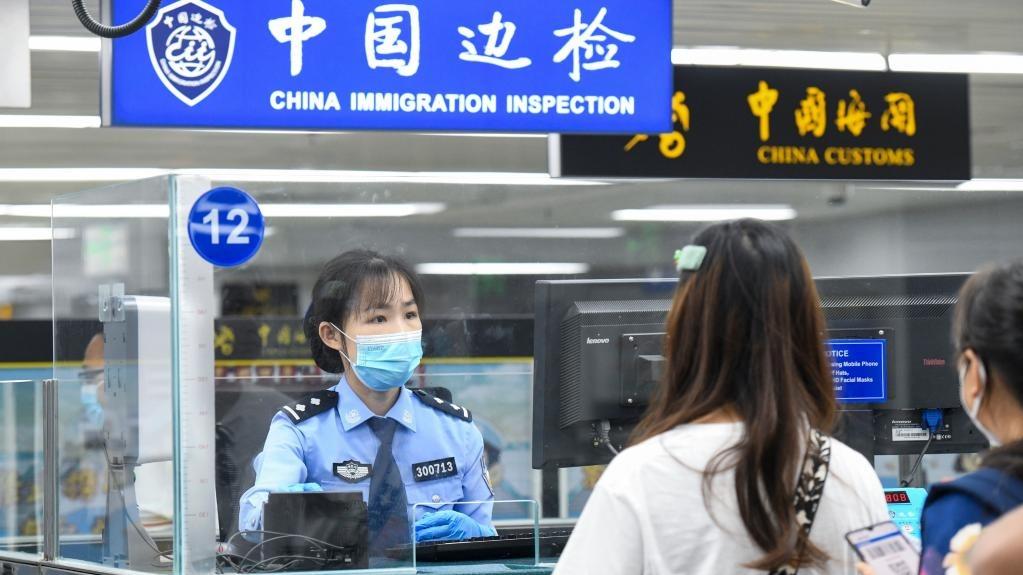 A police officer handles exit formalities of tourists at Luohu Port in Shenzhen, south China's Guangdong province, on May 3, 2023. (PHOTO / XINHUA)
A police officer handles exit formalities of tourists at Luohu Port in Shenzhen, south China's Guangdong province, on May 3, 2023. (PHOTO / XINHUA)
The Exit and Entry Port Office of the Shenzhen Municipal People’s Government unveiled an array of measures on Tuesday to bolster facilities and improve the experience of travelers at its land ports, in an effort to promote deeper integration between the Chinese mainland and Hong Kong.
The 18 measures include setting up zones for tourism promotions, improving port operations, strengthening mobile signal coverage and providing free services for visitors. These services include wheelchair accessibility for individuals with disabilities, access to emergency medical kits, and travel consultations.
The launch of the co-location arrangement means that the Lok Ma Chau border control point can be removed, increasing space for the development of innovation and technology parks there
The authorities said they are exploring ways to resolve the counterflow issue at Gate 1 of Luohu Port. In addition, express lanes for crossborder coaches at Huanggang Port will be established to expedite vehicle flow and minimize passenger waiting time; and the operating hours for Gate 15 at Futian Port are to be extended from the current 7 am to 3 pm, to 7 am to 8 pm, according to the announcement.
READ MORE: Luohu to enhance Shenzhen-HK integrated development
Temporary financial service stations will also be set up at the ports to assist Hong Kong travelers with using e-payment platforms, such as WeChat Pay, Alipay, and UnionPay Mobile QuickPass.
At a news conference on Tuesday, Wang Gang, director of Shenzhen Exit and Entry Port Office, said, in order to help Hong Kong residents traveling north to spend more freely, currency conversion points have been established at Shenzhen’s ports, and QR codes are displayed to enable the easy downloading of mobile payment apps. Also, the surrounding areas are now equipped with free Wi-Fi to ensure smooth internet connection, he added.
Wang said the authority plans to implement a “frequent traveler” program at Luohu Port. Specific groups such as students, businesspeople and technology professionals, once registered as “frequent travelers”, will enjoy more convenient customs clearance and inspections under the program.
Describing Luohu as “a symbol of the reform and opening-up”, he said the government would not “demolish and rebuild” Luohu Port, but would maintain its individual character.
Luohu Port has remained the top port in terms of passenger volume since the border reopened earlier this year following the COVID pandemic. A total of 23 million trips had been made through Luohu Port between Jan 8 and Aug 7. Second-placed Futian Port handled 21 million trips.
Wang added that after Huanggang Port, which is under renovation, comes into service in 2026, it will not only feature the co-location arrangement, but will also adopt a “collaborative inspection and joint clearance” model.
READ MORE: HK, Shenzhen to discuss special cross-border policy in HSITP
The launch of the co-location arrangement means that the Lok Ma Chau border control point can be removed, increasing space for the development of innovation and technology parks there, Wang added.
Shenzhen’s land ports linking to Hong Kong have seen a notable increase in passenger traffic since quarantine-free travel was resumed on Jan 8. According to data from the Immigration Department, people from Hong Kong made a total of 4.68 million trips to the mainland in July, an increase of 210,000 from the previous month.
Based on estimates from government figures, the total spending of Hong Kong travelers on the Chinese mainland could reach up to HK$4 billion ($512 million) in July, according to a local media outlet.
Contact the writer at tianyuanzhang@chinadailyhk.com


